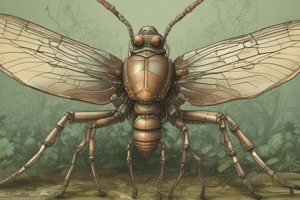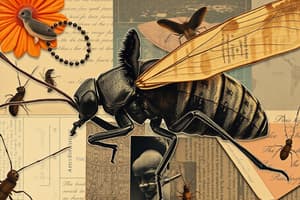Podcast
Questions and Answers
What type of mouthparts do mosquitoes possess?
What type of mouthparts do mosquitoes possess?
- Sucking mouthparts (correct)
- Chewing mouthparts
- Sponging mouthparts
- Lapping mouthparts
Which arthropod is known for having chewing mouthparts?
Which arthropod is known for having chewing mouthparts?
- Houseflies
- Butterflies
- Cockroaches (correct)
- Ticks
What distinguishes lapping mouthparts from other types?
What distinguishes lapping mouthparts from other types?
- They include a long, tube-like structure.
- They are specialized for licking up liquids. (correct)
- They are designed for piercing host tissues.
- They use a spongy labellum to soak up liquids.
Which of the following mouthpart types combine piercing and pumping structures?
Which of the following mouthpart types combine piercing and pumping structures?
Which arthropod features a long proboscis for feeding on nectar?
Which arthropod features a long proboscis for feeding on nectar?
Flashcards are hidden until you start studying
Study Notes
Mouthparts in Arthropods
-
Functionality: Mouthparts are adapted to the feeding habits of various arthropod species, playing a critical role in their diet.
-
Main Types of Mouthparts:
-
Chewing Mouthparts:
- Found in insects like grasshoppers and beetles.
- Comprise mandibles (for biting and grinding), maxillae (manipulating food), and labrum (upper lip).
-
Sucking Mouthparts:
- Adapted for feeding on liquids (e.g., nectar, blood).
- Includes:
- Proboscis: Long, tube-like structure (e.g., butterflies).
- Stylets: Needle-like structures used to pierce (e.g., mosquitoes).
-
Lapping Mouthparts:
- Specialized for licking up liquids.
- Found in bees and some flies; feature a proboscis that can lap up nectar.
-
Sponging Mouthparts:
- Present in some flies (e.g., houseflies).
- Composed of a spongy labellum that soaks up liquid food.
-
-
Additional Adaptations:
-
Piercing Mouthparts:
- Adapted for penetrating host tissues (e.g., ticks).
- Combine piercing stylets with a pump-like structure for feeding.
-
Biting Mouthparts:
- Common in predatory arthropods (e.g., spiders).
- Utilizes chelicerae to grasp and immobilize prey.
-
-
Evolutionary Importance:
- Mouthpart variations reflect dietary adaptations and ecological roles.
- Influence interactions with the environment and other organisms, including pollination and predation.
-
Examples of Arthropods and Their Mouthparts:
- Cockroaches: Chewing mouthparts for omnivorous diet.
- Mosquitoes: Sucking mouthparts for blood-feeding.
- Butterflies: Long proboscis for nectar feeding.
- Spiders: Biting mouthparts for predation.
-
Summary: Arthropod mouthparts exhibit a diverse range of structures and functions, crucial for their survival and ecological niches. Understanding these adaptations provides insight into their biology and interactions within ecosystems.
Mouthparts in Arthropods
- Mouthparts function are essential for the feeding habits of arthropods, influencing their dietary choices and survival.
Main Types of Mouthparts
-
Chewing Mouthparts:
- Common in arthropods like grasshoppers and beetles.
- Composed of mandibles for biting and grinding, maxillae for food manipulation, and labrum serving as the upper lip.
-
Sucking Mouthparts:
- Adapted for liquid consumption, such as nectar or blood.
- Proboscis: A long, tube-like structure found in butterflies for sipping fluids.
- Stylets: Needle-like structures enabling piercing of host tissues, prevalent in mosquitoes.
-
Lapping Mouthparts:
- Specialized for licking liquids, observed in bees and certain flies.
- Feature a proboscis that aids in nectar collection.
-
Sponging Mouthparts:
- Characteristic of some flies, including houseflies.
- Comprises a spongy labellum that absorbs liquid food.
Additional Adaptations
-
Piercing Mouthparts:
- Designed to penetrate host tissues; found in ticks.
- Combine piercing stylets with a pump mechanism for effective feeding.
-
Biting Mouthparts:
- Typical in predatory arthropods, such as spiders.
- Utilize chelicerae to grasp, immobilize, and consume prey.
Evolutionary Importance
- Mouthpart diversity reflects dietary adaptations and ecological roles in arthropods.
- Variations influence interactions with the environment, including roles in pollination and predation.
Examples of Arthropods and Their Mouthparts
- Cockroaches: Possess chewing mouthparts suitable for an omnivorous diet.
- Mosquitoes: Feature sucking mouthparts specifically adapted for blood-feeding.
- Butterflies: Utilize a long proboscis for efficient nectar feeding.
- Spiders: Equipped with biting mouthparts for capturing prey.
Summary
- The diversity of mouthparts in arthropods reveals critical adaptations for survival and ecological niches.
- Understanding these structures enhances knowledge of their biology and ecosystem interactions.
Studying That Suits You
Use AI to generate personalized quizzes and flashcards to suit your learning preferences.




